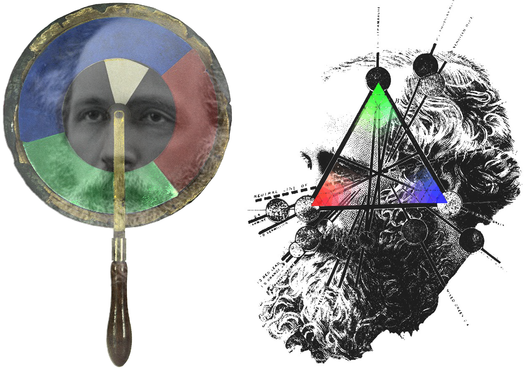James Clerk Maxwell1831–1879
Maxwell rendered the investigation of colour vision a quantitative science and applied it to the analysis of anomalies in colour perception. He revived Young’s three colour theory, as did Helmholtz, but provided a more complete defence of it. The essential difference between their approaches was that Maxwell appreciated that subtraction as well as addition was required in order to produce all colours from three primaries. Moreover, Helmholtz had argued that the three-colour mechanism acted at the level of the specific nerve energies whereas Maxwell, like Young, contended that there were three different colour receptors. Support for this derived from his studies of colour defective individuals, who could be classified according to the colour receptors that were absent or anomalous. Maxwell introduced the method that has become standard in experiments on colour mixing: “The coloured paper is cut into the form of discs, each with a small hole in the centre, and divided along a radius, so as to admit of several of them being placed on the same axis, so that part of each is exposed”. When the device, often called Maxwell’s disk, was rotated rapidly the colours combined: “I have found by independent experiments, that the colour produced by fast spinning is identical with that produced by causing the light of the different colours to fall on the retina at once”. He is shown, on the left, in the colour disc he used for his experiments. Later, smaller discs were added so that comparisons could be made during rotation. Most colour defectives could match any colour with only two of the primaries. The resulting equations led to the proposal of a three-dimensional colour solid, with variables that would now be called hue, saturation and intensity. The location of white in the colour solid was of critical importance: hue was determined by the angular position with respect to white, and saturation by the distance from white. Maxwell considered that colour was the province of physics rather than phenomenology: “I think there is a good deal to be learned from the names of colours; not about colours, of course, but about names”. Maxwell was born in Edinburgh and studied physics at its university followed by mathematics at Cambridge. He held posts at Aberdeen and London Universities before his appointment, in 1871, as foundation professor of experimental physics at Cambridge University. He commenced his colour experiments at Edinburgh and returned to them throughout his life. In 1861 he demonstrated the first colour photograph to a meeting at the Royal Institution. Separate photographs of a tartan ribbon were taken through red, green, and blue filters and projected through similar filters. The colour triangle had its origins in Young’s work, but it was subsequently modified by Maxwell. On the right, he is portrayed in combination with a diagram illustrating the chromatic relations of coloured papers; ultramarine, vermillion and emerald-green occupy the corners.
